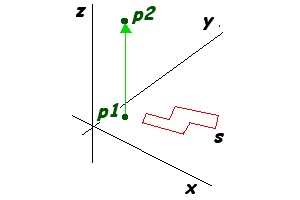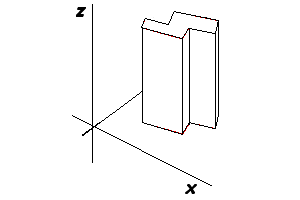TAPESTRY: The Art of Representation and Abstraction
Derivative Geometry: Extrusion
 Extrusion is the simplest of a set of modeling transformations which involve moving a uniform cross-section along a path in space.
Extrusion is the simplest of a set of modeling transformations which involve moving a uniform cross-section along a path in space.Thus, extrusion involves a 2D shape (s) and a straight line-segment (p1-p2) in space, as shown in the figure at right.
The 2D shape determines the cross-section of the extruded form. The line-segment marks the starting and ending points of the extruded form in space.
 The resulting form is generated in two steps. In the first step, the cross-section shape is duplicated to create the top and bottom of the result. In the second step, the top and bottom are joined together with parallel sides. Faces are generated in each case such that they face outward.
The resulting form is generated in two steps. In the first step, the cross-section shape is duplicated to create the top and bottom of the result. In the second step, the top and bottom are joined together with parallel sides. Faces are generated in each case such that they face outward.
Variations
Sometimes the extrusion is perpendicular to the plane of the 2D shape, but this is not required. Nor is it (strictly) required that the shape be flat.
Possible problems
It should be noted that extruding in a negative direction, like revolving or scaling in a negative direction, can result in "inverting" a shape (turning it inside out) unless the program properly handles this condition.
Last updated: April, 2014
